This List of California bouldering sites, includes locations within the state of California, United States, that are known for the rock climbing style of bouldering.
This List of California bouldering sites, includes locations within the state of California, United States, that are known for the rock climbing style of bouldering.
| Name | Nearest city | County | Coordinates | Comments |
|---|---|---|---|---|
| Bishop | Bishop | Inyo | 37°21′49″N117°23′42″W / 37.36361°N 117.39500°W | Numerous locations with over 2000 boulder problems. [1] |
| Mount Rubidoux | Riverside | Riverside | 33°59′02″N117°23′35″W / 33.9839038°N 117.3931011°W | A good site for beginners to practice a large variety of boulder problems and top-rope routes. [2] |
| Bernasconi Ridge | Perris | Riverside | 33°50′47″N117°09′16″W / 33.846407°N 117.154478°W | The Bernasconi Wall provides a quality top-roping opportunity. [3] |
| Deer Creek Park | Rocklin | Placer | 38°47′13″N121°14′22″W / 38.787064°N 121.23949°W | East of Sacramento, just a few minutes from I-80 on the side of Pacific street in the town of Rocklin, is an old granite quarry called Deer Creek Park. It sports about 50 fun and challenging vertical to slightly overhanging problems. A small grove of trees gives shade in the summer and clean flat landings with pieces of carpet straight out of the old school keep the feet dry in between tries. The granite from this quarry was used to build the State Capitol as well as parts of the Central Pacific Railway. About 10-20 good lines from VB to V-hard are concentrated into the main area with more on the surrounding boulders. Bouldering and even a little toprope climbing has been enjoyed here since at least the 1970s. [4] |
| Santee Boulders | Santee | San Diego | 32°50′48″N117°01′17″W / 32.846712°N 117.02126°W | "Easy access makes Santee Boulders a popular after work hangout. While several rocks are tall enough so that toproping is recommended (bolts on top), most of the climbing in this compact area requires only shoes and chalk bag. Over 100 problems are crammed onto 30 or so granite boulders. Thin, crimpy face climbing, and difficult mantles dominate the climbing at Santee, so bring a good fitting pair of shoes if you want to master the many micro edge problems." [5] |
| Castle Rock | Santa Cruz | Santa Cruz | 37°13′50″N122°05′44″W / 37.23060°N 122.09568°W | "The highest concentration of boulder problems in the Bay Area is side by side with great sport and trad crags. All this combined with legitimate access from one easily located parking area makes it the most popular all around rock climbing venue in the Bay Area." [6] |

Bouldering is a form of free climbing that is performed on small rock formations or artificial rock walls without the use of ropes or harnesses. While bouldering can be done without any equipment, most climbers use climbing shoes to help secure footholds, chalk to keep their hands dry and to provide a firmer grip, and bouldering mats to prevent injuries from falls. Unlike free solo climbing, which is also performed without ropes, bouldering problems are usually less than six metres (20 ft) tall. Traverses, which are a form of boulder problem, require the climber to climb horizontally from one end to another. Artificial climbing walls allow boulderers to climb indoors in areas without natural boulders. In addition, bouldering competitions take place in both indoor and outdoor settings.

Half Dome is a quartz monzonite batholith at the eastern end of Yosemite Valley in Yosemite National Park, California. It is a well-known rock formation in the park, named for its distinct shape. One side is a sheer face while the other three sides are smooth and round, making it appear like a dome cut in half. It stands at nearly 8,800 feet above sea level and is composed of quartz monzonite, an igneous rock that solidified several thousand feet within the Earth. At its core are the remains of a magma chamber that cooled slowly and crystallized beneath the Earth's surface. The solidified magma chamber was then exposed and cut in half by erosion, therefore leading to the geographic name Half Dome.

A climbing route is a path by which a climber reaches the top of a mountain, or rock/ice-covered obstacle. The details of a climbing route are recorded in a climbing guidebook and/or in an online climbing route database, and will include elements such as the type of climbing route, the difficulty grade of the route–and beta on its crux(es)–and any risk or commitment grade, the length and number of pitches of the route, and the climbing equipment needed to complete the route.
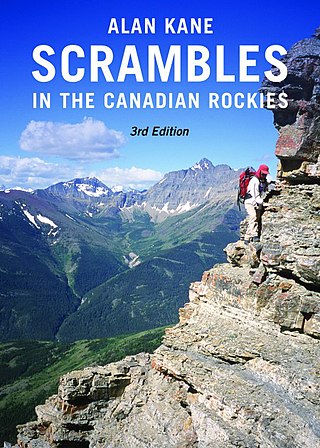
Climbing guidebooks are used by mountaineers, alpinists, ice climbers, and rock climbers to locate, grade, and navigate climbing routes on mountains, climbing crags, or bouldering areas. Modern route guidebooks include detailed information on each climbing route, including topo diagrams, route beta, protection requirements, and the ethics and style that are in place for a given climbing area.

Chris Omprakash Sharma is an American rock climber who is considered one of the greatest and most influential climbers in the history of the sport. He dominated sport climbing for the decade after his 2001 ascent of Realization/Biographie, the world's first-ever redpoint of a consensus 9a+ (5.15a) graded route, and ushered in what was called a "technical evolution" in the sport. Sharma carried the mantle of "world's strongest sport climber" from Wolfgang Güllich, and passed it to Adam Ondra.

Rock climbing is a sport in which participants climb up, across, or down natural rock formations or indoor climbing walls. The goal is to reach the summit of a formation or the endpoint of a usually pre-defined route without falling. Rock climbing is a physically and mentally demanding sport, one that often tests a climber's strength, endurance, agility and balance along with mental control. Knowledge of proper climbing techniques and the use of specialized climbing equipment is crucial for the safe completion of routes.
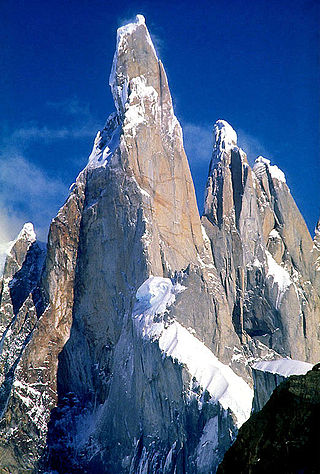
Cerro Torre is one of the mountains of the Southern Patagonian Ice Field in South America. It is located in Argentina and Chile, west of Fitz Roy. The peak is the highest of a four mountain chain: the other peaks are Torre Egger, Punta Herron, and Cerro Standhardt. The top of the mountain often has a mushroom of rime ice, formed by the constant strong winds, increasing the difficulty of reaching the actual summit.
Lisa Rands is an American rock climber. She is known for her bouldering for which in 2002, she became the first American female to win IFSC World Cup bouldering competitions, and topped the IFSC world boulder rankings in 2002. Rands was the first American female to climb boulders of grade V11 (8A), and V12 (8A+), and was the second-ever female in history to climb a 7C+/8A boulder. As well as making first female ascents (FFAs) of boulders such as The Mandala V12 (8A+), Rands was the first female in history to do an E8-graded traditional climbing route, The End of the Affair.

Beta is a climbing term that designates information about how to ascend a climbing route, and the specific climbing techniques required—and how to apply them—to overcome the key challenges encountered. Traditionally sourced in climbing guidebooks, online databases and apps now provide detailed climbing beta. The term is attributed to Texan climber Jack Mileski.
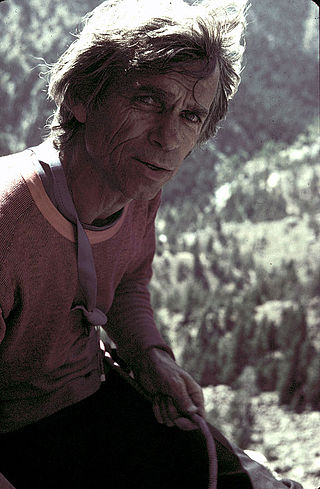
Bob Kamps was an American rock climber whose climbing career spanned five decades. Born in Wisconsin, he began climbing in California in 1955, and was a member of that cadre of Yosemite pioneers who first ascended many of its great walls in the 1950s and 1960s. He was particularly adept on steep rock faces, and was among the first to shift attention from aid climbing to free climbing. Over the years he made more than 3,100 climbs. Many were first ascents or first free ascents.
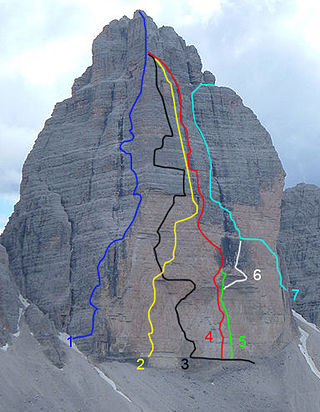
In climbing, a topo is a graphical representation of a climbing route. Topos range from a photograph of the climb on which the line of the route is overlaid, to a detailed diagram of the key features and challenges of the climb, which are typically represented as standardized UIAA topo symbols.

Sentinel Rock is a granitic peak in Yosemite National Park, California, United States. It towers over Yosemite Valley, opposite Yosemite Falls. Sentinel Rock lies 0.7 miles (1.1 km) northwest of Sentinel Dome.

Adam Ondra is a Czech professional rock climber, specializing in lead climbing, bouldering, and competition climbing. In 2013, Rock & Ice described Ondra as a prodigy and the leading climber of his generation. Ondra is the only male athlete to have won World Championship titles in both disciplines in the same year (2014) and is one of the two male athletes to have won the World Cup series in both disciplines.

The Nose is a big wall climbing route up El Capitan. Once considered impossible to climb, El Capitan is now the standard for big wall climbing. It is recognized in the historic climbing text Fifty Classic Climbs of North America and considered a classic around the world.

Lover's Leap is a steep granite cliff band in El Dorado County, California, United States, a landmark which catches the eye as one travels by, and a popular destination for climbers. The origin of its name is unknown, but common to most Lover's Leaps, one version from local folklore says two Native Americans lovers leapt to their deaths from the summit.
Paul David Robinson is an American professional rock climber who specializes in bouldering. He has established and repeated several bouldering problems at the V15 difficulty rating, in such areas as Hueco Tanks, the Buttermilks, and Magic Wood. In 2007, Robinson became the second climber in history to successfully climb a V13 boulder problem in one attempt.
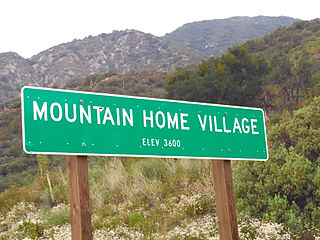
Mountain Home Village is an unincorporated community in San Bernardino County, California, United States with a population of 170 full-time residents as of 2010. Mountain Home Village is located along California State Route 38 5.2 miles (8.4 km) north-northeast of Yucaipa. It is located less than a mile east from the Thurman Flats Picnic Area, and the Loch Leven- and Mill Creek Campgrounds are located in the village. It is also where Mill Creek and Mountain Home Creek meets, while other creeks in area includes Skinner Creek, East Fork Mountain Home Creek, and Frustration Creek. The Mentone Boulders is also located nearby, which is a well-known rock-climbing area. It is located in the San Bernardino Mountains, just at the edge of the San Andreas Fault and offers some extraordinary valley views, and on clear days, also views of the City of San Bernardino. There are also numerous hiking trails located by the village. It is located within the San Bernardino National Forest and is surrounded by pine forest. Its elevation is 3600 feet. In 1956, the Christian Church purchased a resort in Mountain Home Village and started the Loch Leven Camp & Retreat Center.

Midnight Lightning is a 7.62-metre (25.0 ft) high granite bouldering route on the Columbia Boulder in Camp 4 of Yosemite National Park. When first solved in May 1978 by American rock climber Ron Kauk, it was graded at V8 (7B/7B+), which was the world's second-ever boulder route at that grade, and the first in North America. Even today, the route is still considered a "hard" V8 grade. Midnight Lightning is the most notable bouldering route in climbing along with Dreamtime, and its ascent is considered an important moment in the history and the development of bouldering as a sport in its own right.
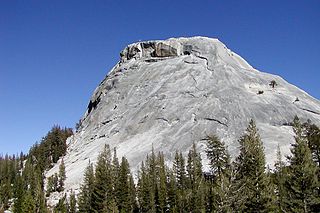
Pywiack Dome is a prominent 600 foot granite dome in Yosemite National Park, located 0.7 miles (1.1 km) north-east of Tenaya Lake, 4 miles (6.4 km) west of Tuolumne Meadows and 200 feet (61.0 m) from the Tioga Road. It is quite near Harlequin Dome, and North and South Whizz Domes are north.

Akiyo Noguchi is a Japanese professional rock climber who specializes in competition bouldering as well as outdoor bouldering and sport climbing.